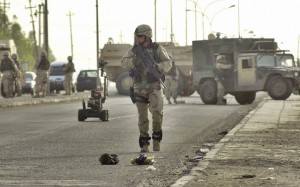Special to WorldTribune.com
The New York Times reported on Oct. 14 that U.S. troops in Iraq had between 2004 and 2011 repeatedly encountered Weapons of Mass Destruction (WMD).
Meanwhile, voters back home and the world at large had been repeatedly told precisely the opposite by U.S. media reports. The Republican administration of George W Bush was condemned on a daily basis by partisans in and out of government for executing a war in Iraq on the false premise that such WMD existed and posed a threat to Iraqis and the region at large.

The Times article was based on an investigation and cited U.S. intelligence documents: “From 2004 to 2011, American and American-trained Iraqi troops repeatedly encountered, and on at least six occasions were wounded by, chemical weapons remaining from years earlier in Saddam Hussein’s rule,” according to the report.
[Related — Report: U.S suspects Iraqi WMD in Lebanon’s Bekaa Valley, Aug. 26, 2003]
“In all, American troops secretly reported finding roughly 5,000 chemical warheads, shells or aviation bombs, according to interviews with dozens of participants, Iraqi and American officials, and heavily redacted intelligence documents obtained under the Freedom of Information Act.”
The Times assured its readers that the new information did not justify the U.S. invasion of Iraq in 2003 before which Secretary of State Colin Powell asserted that Iraq had an active WMD program. The chemical weapons discovered by U.S. troops were old and not from active programs, the article clarified.
The Times report did not address reports that tractor trailer convoys had been observed by western intelligence leaving Iraq for Syria and ultimately Lebanon’s Bekaa Valley in January 2003. The reports by WorldTribune.com and Geostrategy-Direct.com were followed by another report in June 2004 on findings by the UN Monitoring, Verification and Inspection Commission from “satellite photographs that demonstrated the speed with which Saddam dismantled his missile and WMD sites before and during the war.”
“Council members were shown photographs of a ballistic missile site outside Baghdad in May 2003, and then saw a satellite image of the same location in February 2004, in which facilities had disappeared,” according to the report.
UNMOVIC acting executive chairman Demetrius Perricos told the UN Security Council that Iraqi missiles were dismantled and exported to such countries as Jordan, the Netherlands and Turkey.
““The removal of these materials from Iraq raises concerns with regard to proliferation risks,” Perricos said.
U.S. intelligence suspected that Iraq’s WMD had been moved to “Lebanon’s heavily-fortified Bekaa Valley, swarming with Iranian and Syrian forces, and Hizbullah and ex-Iraqi agents,” according to the WorldTribune report.
A “multi-million dollar deal between Iraq and Syria provided for the hiding and safekeeping of Saddam’s strategic weapons,” according to the report.
As for the subsequent discoveries of older shells, the Pentagon kept a tight lid of secrecy on reports from U.S. forces, according to yesterday’s New York Times report.
“Jarrod L. Taylor, a former Army sergeant on hand for the destruction of mustard shells that burned two soldiers in his infantry company, joked of ‘wounds that never happened’ from ‘that stuff that didn’t exist.’ The public, he said, was misled for a decade. ‘I love it when I hear, ‘Oh there weren’t any chemical weapons in Iraq,’ ‘ he said. ‘There were plenty.’ ”
Troops who were injured when uncovering the shells were sworn to secrecy. “They put a gag order on all of us — the security detail, us, the clinic, everyone,” one officer quoted in the article said. “We were briefed to tell family members that we were exposed to ‘industrial chemicals,’ because our case was classified top secret.”
The Times was careful to point out: “The discoveries of these chemical weapons did not support the government’s invasion rationale. After the terrorist attacks of Sept. 11, 2001, Mr. Bush insisted that Mr. Hussein was hiding an active weapons of mass destruction program.”
But the evidence discovered, but kept secret, during the most recent U.S. incursion into Iraq was of an earlier WMD program, the report said.

You must be logged in to post a comment Login